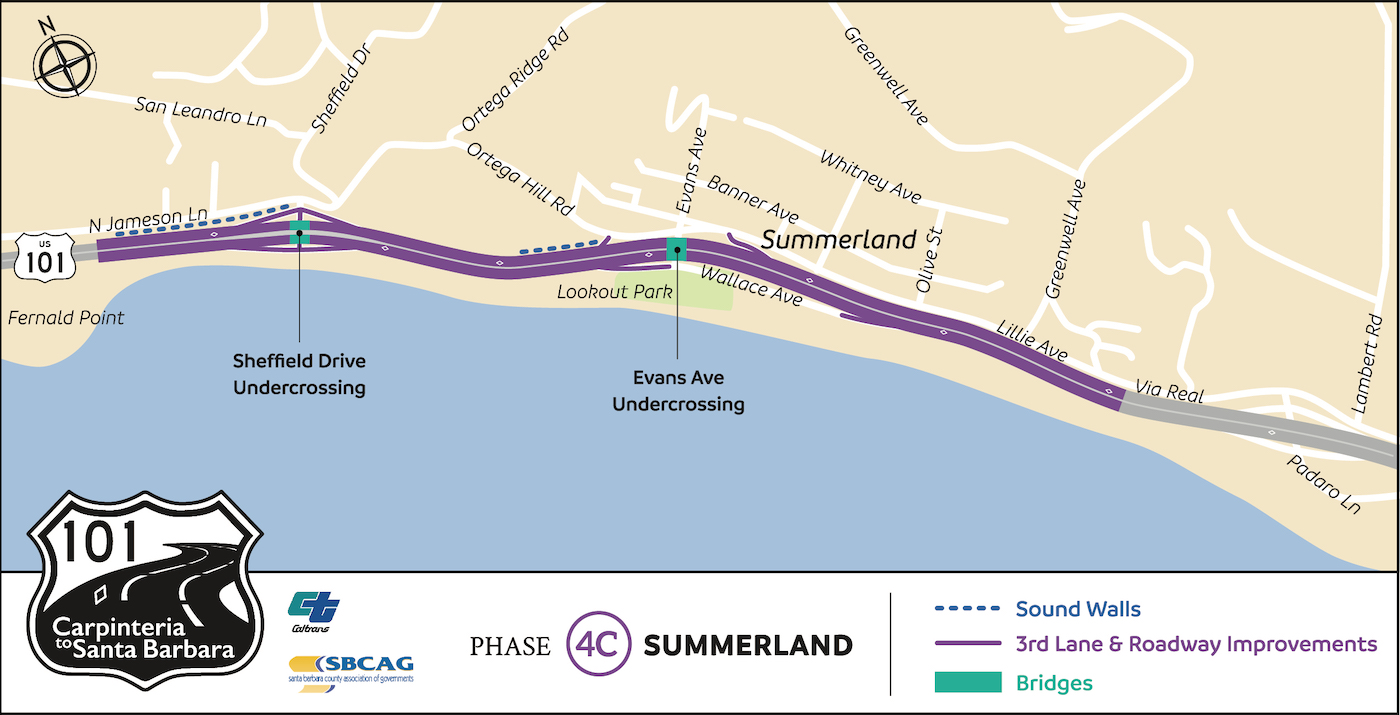Land Use Discusses 101 Widening

At their meeting last week, the Montecito Association (MA) Land Use Committee received a status update on the expansion of Highway 101.
Matt Dobberteen, Alternative Transportation manager with Public Works, said that a design team has been hard at work refining the design of the highway widening through landscaping, hardscaping, and signage. “Because it is located in the coastal zone, the area has tremendous scenic value,” Dobberteen said.
Deputy Corridor manager Fred Luna recapped that two of the four phases of the highway-widening project are complete; Phase 3 is currently in progress in Carpinteria and will be finished in 2019. Phase 4 includes 10 miles of expansion which is being discussed in five phases and spans from the Carpinteria City boundary to line in Carpinteria to Sycamore Creek in the City of Santa Barbara.
The section of the freeway discussed at Land Use was the six miles located in the County, from the Carpinteria City line to the Sheffield interchange, which is being completely rebuilt and will include two separate bridges for the southbound and northbound sides. The left-hand exit and entrance on the southbound side will be changed to be on the right side, and sound walls and retaining walls will be added on the northbound side. The expansion at that interchange does not allow for median landscaping; some members of the Land Use Committee suggested planting trees beneath the freeway bridge, which would grow between the two Sheffield bridges.
“We take a good hard look at what it will look like and the experience drivers will have,” Dobberteen added, saying there have been at least 10 design meetings, which include reps from Public Works, Caltrans, SBCAG, MBAR, South Coast BAR, and Montecito Association.
Caltrans project manager Dave Emerson explained that the design of the undertaking is subject to many different sets of guidelines, including Santa Barbara County zoning ordinances, Montecito architectural and design guidelines, Highway 101 corridor guidelines, and others. The design team is ensuring that the project’s design elements will be Spanish in style and complement the semi-rural nature of Montecito. “These bridges might be up for one hundred years, so we want them to look like they’ve always been there,” Dobberteen said.
Luna explained that Phases 4A, 4B, and 4C are fully funded thanks to Senate Bill 1, which increased the state gas tax. But the funding is currently in jeopardy; it will be eliminated if Proposition 6 passes. “Our ability to fund projects has been declining due to inflation and construction costs,” Luna said, adding that gas tax revenues have declined due to hybrid vehicles. “The buying power of that gas tax has affected the long-term stability of the funding.”
If Prop 6 fails, planning will continue on Phases 4D and E, which will widen Highway 101 to three lanes in each direction between Sycamore Creek up to Romero Creek in Montecito (west of Sheffield Drive). Included are the reconstruction of the bridges over Cabrillo Boulevard and a new southbound on-ramp (replacing the left-hand ramp removed in Phase 1). Bridges will be replaced at Montecito, San Ysidro, Oak, and Romero Creeks.
The entirety of Phase 4 is estimated to cost $585 million; construction is slated to start in 2020. The team will be back in front of the Land Use Committee next month with more design renderings.
Also at the meeting, Judy Weisbart of the World Business Academy gave a quick summary of a project initiative from the World Business Academy and the Clean Coalition. The groups are collaborating to build a community microgrid in Montecito to ensure indefinite energy at critical facilities during an emergency. “One of the major issues for our first responders during the mudslide was the lack of electricity to run vital systems,” Weisbart said.
The grid, which will be solar-powered, is slated to be built behind the Montecito Fire District on San Ysidro Road; the microgrid would power the MFPD headquarters, Montecito Water District headquarters, wells, and pumping stations, as well as local life-sustaining emergency shelter and supply facilities. The project will eventually expand farther to include the commercial properties in the upper village, Weisbart said, adding that a second phase of the endeavor will include staging a community microgrid for implementation in the lower portion of Montecito.
A meeting is scheduled for Monday, October 29, at Montecito Union School to discuss this initiative. For more information, visit www.clean-coalition.org/our-work/community-microgrids/.
The Land Use Committee also discussed a grassroots idea that was born on the social media network, Nextdoor. Lesley Weinstock and Nicole Daniel have formed a group of residents who wish to ban gas-powered leaf blowers. With more than 100 signatures on a petition, the group is asking the Montecito Association to endorse the idea, which is already in effect in the City of Santa Barbara. Weinstock said that gas leaf blowers cause fumes, chemicals, dust, respiratory issues, and damaging noise. The committee voted unanimously to support the concept of a gas-powered leaf blower ban that will be discussed by the full MA board.
Land Use chair Cori Hayman, who is running for a seat on the Montecito Water District board of directors, let the committee and the audience know that her candidacy is separate from her role on the Association, but that she would not be continuing as Land Use chair if she is elected.
For more information about the Montecito Association, visit www.montecitoassociation.org.







